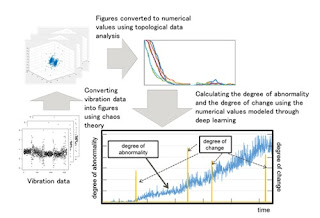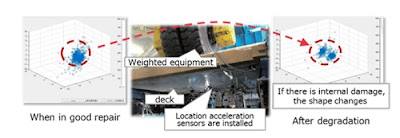Learning Technology Successfully Estimates Degree of Internal Damage to Bridge
Infrastructure
degradation with surface-mounted sensors
Limited and Fujitsu Laboratories Ltd. today announced the development of sensor
data analysis technology that can aggregate vibration data with sensors
attached to the surface of a bridge, and then estimate the degree of the bridge’s
internal damage through the application of “FUJITSU Human Centric AI
Zinrai technology,” Fujitsu’s approach to artificial intelligence.
This technology was validated using data
obtained from verification tests of fatigue degradation of bridges(1) carried
out by the Research Association for Infrastructure Monitoring System
(RAIMS)(2), a mutual aid organization that carries out joint research into
technologies used in industrial activities.
In this way the technology enables enhanced
maintenance and management tasks, making it possible to remotely estimate the
degree of internal damage to bridge infrastructure.
Details of this technology will be announced at
the Japan Society of Civil Engineers 2017 Annual Meeting, to be held at Kyushu
University on September 11-13, 2017.
Development Background
As many bridges built in Japan’s period of high
economic growth continue to deteriorate, the work required to maintain and
manage this type of infrastructure has increased rapidly, accompanied by social
problems including rising maintenance costs and a shortage of engineers.
It is anticipated that these issues may now be
resolved through the application of ICT to maintenance and management tasks for
bridges and other social infrastructure.
Issues
Inspection tasks for bridges are usually
performed visually to check the structure for damage. The issue with relying
only on information gathered visually, however, is that inspectors can only
identify abnormalities or anomalies appearing on the structure’s surface, and
are consequently unable to grasp information regarding the degree of internal
damage.
In recent years, in order to advance the use of
ICT in these inspections, there have been many trials in which sensors were
attached to the surface of the bridge deck(3), using vibration data to evaluate
the level of damage. With the methods used until now, accurately understanding
the degree of damage within the interior of the deck was an issue.
About the Newly Developed Technology
Now, by expanding Fujitsu Laboratories’
proprietary deep learning AI technology for time-series data(4), Fujitsu and
Fujitsu Laboratories have developed technology that can discover anomalies and
express in numerical terms degrees of change that demonstrate drastic changes
in the status of objects such as structures or machinery, and detect the
occurrence of abnormalities or distinctive changes. The technology learns from
the geometric characteristics extracted from complex, constantly changing
time-series vibration data collected by sensors equipped on IoT devices (Figure
1), thus enabling users to estimate and validate the state of degradation or
failure in a variety of social infrastructure or machinery.
This technology has now been confirmed through
the application of verification test data from RAIMS.
Figure 1: Analysis of vibration data with this
technology
Results of the Verification Test
This newly developed technology was applied to
vibration data collected from acceleration tests (wheel load running test)
performed by RAIMS. The results showed that the geometric characteristics
extracted from the vibration data by this technology would appear as a single
cluster when the bridge was intact, but the shape changes when the bridge had
developed internal damage (Figure 2). Moreover, it was confirmed that the
degree of abnormality and the degree of change that can be calculated by
converting the geometric characteristics to numerical values correspond with
the results measured by strain sensors embedded within the bridge deck,
validating the effectiveness of the technology.
Figure 2: Results of the verification test
Effects
From the analysis results of data from an
acceleration sensor at a single location on the surface of a bridge, Fujitsu
confirmed that it is possible to estimate the degree of damage(5) across a wide
area of a bridge’s interior using this technology. Additionally, detecting the
occurrence of internal stress using this technology allows for the estimation of
damage in its earliest stages, and can contribute to early countermeasures.
Duplicating these tests in the future will make it possible to remotely
estimate the degree of internal damage with a high degree of accuracy using
surface-mounted sensors, enabling the enhancement of bridge maintenance and
management tasks.
Future Plans
Fujitsu will conduct trials using vibration data
from actual bridges, with the goal of real-world usage by around 2018.
(1) Verification tests of fatigue degradation of
bridges
This verification test was carried out by RAIMS,
as part of a commissioned research project on the research and development of
technology promoting the use of monitoring technology for societal
infrastructure, commissioned by the Ministry of Land, Infrastructure, Transport
and Tourism as part of the Cabinet Office’s Cross-ministerial Strategic
Innovation Promotion Program (SIP), promoting technology to manage, update, and
maintain infrastructure. Summary of the verification tests conducted by RAIMS
Goal: Evaluate technology for monitoring the fatigue degradation of bridges
Testing period: July-August 2015 Testing summary: Acceleration test to recreate
the process of fatigue degradation of bridge decks in simulation, using an
actual-size bridge deck and heavy load equipment (weighted wheeled testing
apparatus). For the test, strain sensors were embedded within the actual-size
bridge deck. In addition, the vibration data that was used for analysis was
collected via acceleration sensors attached to the surface of the bridge deck.
Location: Yamaguchi University
(2) Research Association for Infrastructure
Monitoring System (RAIMS)
An organization consisting of 14 companies and
legal entities, with the goal of promoting the rapid commercialization of
monitoring technology. Fujitsu also carries out research and development as a
member of the association.
(3) Bridge deck
The floor or surface of the bridge, which
transfers the weight of vehicles travelling over the bridge to the columns or
girders supporting the bridge.
(4) Deep learning technology for time-series
data
Proprietary technology from Fujitsu Laboratories
that accurately analyzes time-series data using a data analysis method called
topological data analysis. “Fujitsu Develops New Deep Learning Technology
to Analyze Time-Series Data with High Precision”.
(5) Estimation of the degree of damage
During the acceleration tests, the degree of
damage to the experimental bridge deck was judged visually by engineers in
accordance with the Japanese Ministry of Land, Infrastructure, Transport and
Tourism’s guidelines for the periodic inspection of bridges, and estimated
according to these results, as well as the results of an AI-based
analysis.
About Fujitsu Laboratories
Founded in 1968 as a wholly owned subsidiary of
Fujitsu Limited, Fujitsu Laboratories Ltd. is one of the premier research
centers in the world. With a global network of laboratories in Japan, China,
the United States and Europe, the organization conducts a wide range of basic
and applied research in the areas of Next-generation Services, Computer
Servers, Networks, Electronic Devices and Advanced Materials. For more information,
please see: http://www.fujitsu.com/jp/group/labs/en/.
About Fujitsu Ltd
Fujitsu is the leading Japanese information and
communication technology (ICT) company, offering a full range of technology
products, solutions, and services. Approximately 155,000 Fujitsu people support
customers in more than 100 countries. We use our experience and the power of
ICT to shape the future of society with our customers. Fujitsu Limited (TSE: 6702)
reported consolidated revenues of 4.5 trillion yen (US$40 billion) for the
fiscal year ended March 31, 2017. For more information, please see http://www.fujitsu.com.
* Please see this press release, with images,
at:
http://www.fujitsu.com/global/about/resources/news/press-releases/
For the LATEST tech updates,
FOLLOW us on our Twitter
LIKE us on our FaceBook
SUBSCRIBE to us on our YouTube Channel!







